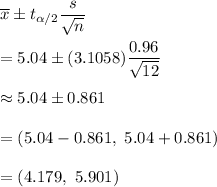Answer with explanation:
As per given , we have


n=12
df = 12-1=11
Since population standard deviation is unknown , so we use t-test.
Critical t-value for 99% confidence (1% significance):

Confidence interval for population mean :_

Hence, the 99% confidence interval for the mean amount of time that students spend in the shower each day. Assume normality.=

a) Lower limit of the 99% interval = 4.179
b) Upper limit of the 99% interval = 5.901